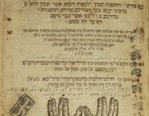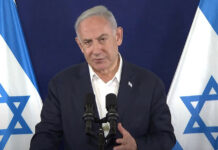 In 1492, when King Ferdinand of Spain ordered his Jewish subjects to “convert or get out,” one of the most glorious periods in the annals of Jewish history came to end: the Golden Age, during which time such great Torah sages as the Rambam, the Ramban, Rav Yehuda Halevi, Rabbeinu Bachya Ibn Pakuda and Rav Shlomo Ibn Gabriol lived.
In 1492, when King Ferdinand of Spain ordered his Jewish subjects to “convert or get out,” one of the most glorious periods in the annals of Jewish history came to end: the Golden Age, during which time such great Torah sages as the Rambam, the Ramban, Rav Yehuda Halevi, Rabbeinu Bachya Ibn Pakuda and Rav Shlomo Ibn Gabriol lived.
The majority of Spain’s Jews, about 300,000, refused to convert and set out in search of a haven where they could live in peace and remain loyal toTorah.
Some reached Portugal, from which they were banished 10 years later. Others went on to Holland and Turkey, where they found refuge. Still others tried to settle in Germany, but they were persecuted and soon continued eastward to Poland.
Poland’s rulers were eager to absorb the Jews, whom they hoped would help boost the economy. They promised them security and freedom of religion. Many Jews settled in Poland, and eventually, Polish Jewry produced many great talmidei chachamim, among them the Bach, the Taz, the Maharam, the Rama, the Maharshal, Rav Yonasan Eibischitz and the Baal Levushim.
One of Poland’s greatest rabbanim of that period was Rav Shmuel Eliezer Halevi Eidels, the Maharsha, son of Rav Yehuda Halevi. He is best known for his profound commentary on the Talmud.
ILLUSTRIOUS STOCK
The Maharsha was born in Krakow in 5315 (1555). His father, Rav Yehuda, was an eminent talmid chacham who descended from Rav Yehuda Hachassid, as well as from Rav Akiva Hakohen Katz, the father-in-law of the Shela Hakadosh.
The Maharsha’s mother also stemmed from an illustrious family. She was the granddaughter of Rav Yehuda Loewe, the Maharal of Prague.
From early childhood, the Maharsha’s remarkable talents were evident. But his brilliance did not adversely affect his character, and he was modest and unassuming.
When he came of marriageable age, the Maharsha was offered many prestigious shidduchim, but all were contingent on his acceptance of important rabbinical positions. Since such positions generally involved communal responsibilities, he rejected them, asserting that he wanted to devote himself solely to Torah study.
During that period, Rebbetzin Eidel Lifschitz of Pozna, the wealthy widow of Rav Moshe Lifschitz, the rav of Brisk, visited Krakow. While there, she made a match between her daughter and the Maharsha. She also offered the young illuy a large dowry and promised that she would enable him to study Torah as long as she was alive. The Maharsha was very impressed by Rebbetzin Lifschitz’s sincere desire to let him devote his life to Torah study, as well as by her daughter’s refined character traits. He accepted the offer.
YEARS OF GROWTH IN TORAH
The Maharsha’s wedding was held in Krakow. Afterward, the Maharsha moved into his mother-in-law’s home in Pozna. But before leaving Krakow, he assembled a group of outstanding talmidei chachamim and brought them with him to Pozna.
His mother-in-law supported this group, enabling the Maharsha to engage in Torah study with its members at all hours of the day. She also supported her other son-in-law, Rav Moshe Ashkenazi, author of Zichron Moshe, with whom the Maharsha studied.
Eventually, the Maharsha expanded this group and it became a yeshiva known as Hachavura Hakedosha.
Before long, the Maharsha became renowned for his vast Torah knowledge, and many prominent Torah sages would consult him on matters of importance to Poland’s Jews.
This included the leaders of the Vaad Arba Ha’aratzos, a special association that represented Poland’s four regions: Large Poland, Small Poland, Galicia and Wohlin. The Vaad instituted many important and effective amendments on behalf of the Jews, and often asked the Maharsha to sign them.
The Vaad also asked the Maharsha to give his haskama to many seforim, including Sefer Haselichos, written by Rav Eliezer Ashkenazi, and the Tzena U’re’ena, written by the Maharshal. In time, the Maharsha became the Vaad’s main spokesman.
The Maharsha studied in Hachavura Hakedosha Yeshiva for 20 years. During that time, his students developed many chiddushim, some of which appear in Zichron Devarim, which was published with financial assistance from the Maharsha’s mother-in-law.
Rebbetzin Eidel passed away in 5368 at the age of 100. However, she didn’t leave behind an inheritance, because she had used all of her vast wealth to support the yeshiva. In appreciation of his mother-in-law’s efforts, the Maharsha added the name Eidels to his own name, and from then on called himself Shmuel Eliezer Eidels.
After the shloshim, a delegation of prominent Jews from the city of Chelem arrived in Pozna, and invited the Maharsha to serve as their rav. The Maharsha accepted the offer.
THE TELLTALE VAV
The Maharsha lived in Chelem for only a short time. Not long after he moved there, he was offered a position as rav of the prominent city of Austroha. He accepted the position, but an argument brewing in nearby Lublin complicated matters.
In Lublin, there were two yeshivos, one headed by the Maharam, Rav Meir of Lublin, and the other by Rav Shimon Zev Auerbach, the Maharshal’ s son-in-law.
These two roshei yeshiva had different approaches to Torah study. Nonetheless, they were on excellent terms with each other. Both yeshivos also studied the same mesechtos because they hoped to publish a joint, proofread edition of the Shas, approved by all of the generation’s Torah sages.
Shortly before the Maharsha was appointed rav of Austroha, the roshei yeshiva were deliberating on a particularly difficult Tosfos, and each interpreted it according to his own personal approach. The Maharam resolved the difficulty according to his pilpul method, while Rav Shimon Zev claimed that the printer had mistakenly deleted the letter “vav” from one of the words in the section in question, making it difficult to understand the text. When the “vav” was reinserted, he contended, the entire text became clear.
In time, the roshei yeshiva’s students began to argue over the issue, and soon, all of the city’s talmidei chachamim were swept up in the debate.
Fearing that the debate, which was truly l’shem Shamayim, might nonetheless split the community, the city’s leaders decided to pose the question to Rav Shlomo Abuhav, Amsterdam’s distinguished rav. They also decided that the rosh yeshiva whose opinion proved wrong would have to step down from his post, and that if both views were wrong, both roshei yeshiva would have to resign.
With that, the mood in the city changed from one of contention to one of anticipation, as all eagerly awaited Rav Abuhav’s answer.
In his reply, Rav Shlomo Abuhav praised both roshei yeshiva, but said that Rav Shimon Zev was correct.
In conformance with the community leaders’ decision, the Maharam resigned. However, Rav Shimon Zev demanded that the resignation be canceled and that the Maharam be reinstated. Pained by the incident, Rav Shimon Zev in turn resigned from his position.
RAV FOR A WEEK
Left without a rav and roshei yeshiva, Lublin’s leaders dispatched a letter to the Maharsha in Austroha, appointing him rav of their city. When the messenger presented the Maharsha with the letter, he told him, “I am coming to Lublin this Shabbos to deliver a drasha.” With this statement, everyone believed that the Maharsha had agreed to become the next rav of Lublin.
Austroha’s Jews were surprised by the turn of events. Their community was much larger than Lublin’s, and Or Torah, the Maharsha’s yeshiva in Austroha, was also very prestigious, having been founded by the Shela Hakadosh. Why had the Maharsha opted to leave their city in favor of Lublin, they wondered. Why had he accepted a rabbinical position that also involved heading two yeshivos at the same time?
That Shabbos afternoon, all of Lublin’s Jews assembled in the main shul to hear what they thought would be the Maharsha’s acceptance speech. The two roshei yeshiva, the Maharam and Rav Shimon Zev Auerbach, were also in attendance, demonstrating their total submission to the city’s new rav. The Maharsha ascended the bima and began, “I have two questions. One pertains to me, the other to you. I have resolved the one pertaining to me. But the one pertaining to you – Lublin’s residents – still troubles me.
“The question that pertains to you is this,” he continued. “How could the heads of this community appointment me rav of Lublin, when Austroha is much larger? The question that pertains to me is: Why did I agree to leave Austroha and come to Lublin?
“The answer is: In all Austroha there are no sages as great in Torah as Rav Meir (the Maharam) and Rav Shimon Zev, Lublin’s roshei yeshiva. I left Austroha and came to Lublin to be in their midst. Your behavior, though, stymies me!”
After that opening, he launched into his Shabbos drasha, not allowing his listeners to react to his earlier remarks.
After his drasha, he concluded, “Since I have accepted your appointment, I am your rav and spiritual guide, and according to din Torah, you must obey me. Now, as your mara d’asra, I demand that you reinstate the two great Torah luminaries, Rav Meir and Rav Shimon Zev, to their former positions.”
After Shabbos, the Maharsha returned to Austroha, and the two roshei yeshiva of Lublin resumed their positions. Because their argument was le’shem Shamayim, Torah study in Lublin only intensified in the years to come.
IN AUSTROHA
The Maharsha’s first step as rav of Austroha was to establish a yeshiva gedola. The yeshiva, Or Torah, quickly expanded, attracting students from all over the region who were eager to hear the Maharsha’s remarkable chiddushim.
During his years as rosh yeshiva in Austroha, the Maharsha compiled his monumental Chiddushei Halachos on the Shas and his Chiddushei Aggados on the aggados of the Talmud. These works were published during his lifetime.
Chiddushei Halachos is considered one of the greatest commentaries on the Talmud, while Chiddushei Aggados is considered a fundamental commentary on its aggados. Throughout the generations, the gedolim have embraced these works.
The Chazon Ish called them, “A good gift for Am Yisroel.” Rav Yona Landsorfer told his sons, “Always study Gemara with Maharsha. Without Ruach Hakodesh, he couldn’t have written a work of that caliber.”
Other Torah sages added, “Disputing the Maharsha is like disputing the Shechina.”
In time, Jews all over the world began to study Chiddushei Halachos. Today it is included in all editions of the Shas and is considered a basic commentary of the Achronim.
BRACHOS THAT MATERIALIZE
As the years passed, more and more students flocked to the Maharsha’s yeshiva, making it necessary to build a larger building.
After much effort, funds were secured to begin building the yeshiva, and a gala cornerstone-laying ceremony was held. As the city’s shamesh was about to launch the sale of the mitzva of the cornerstone laying, someone whispered to him, “I want to purchase that mitzva at all costs, but please don’t reveal my identity.” The man then requested that the ceiling price for the mitzva be 500 golden dinars, and gave the shamesh that sum. The “sale” began at 50 dinars, and it climbed all the way to 460. When the shamesh called out 500 dinars, no one could match it. As the shamesh was about to announce the “winner,” the donor hushed him and said, “I bought the mitzva for the Maharsha. Summon him to lay the cornerstone and don’t announce my name.”
After the ceremony, the Maharsha asked the shamesh to call the donor into his study. The donor explained to the Maharsha that he wasn’t a wealthy man, and that the 500 dinars he had paid for the cornerstone laying constituted nearly all his savings. He added that since he had no children, he hoped that the mitzva of kavod haTorah would stand him in good stead in the World to Come.
The Maharsha was touched by the donor’s words and blessed him that he would have a son who would study in the new yeshiva. Within a year, the donor’s wife gave birth to a boy. When the child reached bar mitzva age, his father brought him to the Maharsha’s yeshiva. The gabbai, however, rejected him on the grounds that he was too young for yeshiva gedola. But the Maharsha, who recognized the father, intervened and warmly welcomed the youth into the yeshiva.
KIND TO ALL
While in Austroha, the Maharsha also attended to the city’s communal needs. It is related that during the period he served as its rav, no Jew in the entire region went hungry.
Quite often, the Maharsha would personally provide for the poor, and his home was always open to the unfortunate. One time, the town’s baker failed to sell a large amount of bread he had prepared. When the Maharsha learned of the baker’s plight, he told him that he had found someone who would buy the bread before it became too stale to sell.
Little did the baker know that the Maharsha was the buyer, and that he had distributed the many loaves of bread he had bought to the town’s needy.
SIYATTA D’SHEMAYA
The Maharsha was a genuine tzaddik who studied Torah day and night and merited great siyatta d’Shmaya. The only time he didn’t study was on “Nittel Nacht,” when he would review his accounts and determine how much maaser money he had to distribute.
One year, one of the city’s ruffians told the police that out of contempt for Christianity’s “savior,” the Maharsha didn’t study Torah on Nittel Nacht. The police agreed to investigate.
That night, as the Maharsha sat in his study going over his accounts, a sefer fell from his bookshelf. The Maharsha picked it up, kissed it and then returned it to its place. Moments later, another book fell, and he picked up that one, too, and returned it to the shelf. The third time a book fell, he picked it up, but for some reason, felt compelled to open it. At that very moment, the police burst into his home. Seeing the Maharsha bent over a book, they stopped in their tracks – and returned to the police station.
MAIN APPROACHES TO LIFE
As evident from his writings, the Maharsha advocated the pursuit of the golden mean in life. Although he opposed luxurious living, saying that it eventually leads to theft, he did not advocate excessive asceticism and self-denial.
He was also concerned about the spiritual development of the youth of his time. In Chiddushei Aggados (maseches Shabbos 119b) he exhorts yeshiva students not spend their time strolling through the streets during bein hazemanim. In a similar vein, he warns against the bitul Torah of young children. Believing that that a student cannot progress without a rav and a chaver, he was very warm to his students and involved them in the formulation of his chiddushim.
Kindness to one’s fellow was the hallmark of his approach to life, and the verse in Iyov “Outside a stranger shall not sleep; my door is open to the wayfarer” was engraved on the arch above his front door.
PETIRA
The Maharsha was niftar on 5 Kislev, 5392, and was buried in Austroha’s Jewish cemetery. The main hesped was delivered by the Chavos Yair ‘s father. Inscribed on his tombstone are the phrases “ish kadosh” and “mofeis hador.”
The Maharsha was survived by sons and sons-in-law, all of whom were gedolei Torah. His sons were Rav Meshulam Zalman, Rav Yehuda Leib and Rav Avraham. His sons-in-law were Rav Yitzchak Segal Charif, the av beis din of Lutzk; Rav Moshe ben Rav Yitzchak, the av beis din of Lublin; and Rav Shlomo Shapira, author of Mavo Shearim.
The Maharsha was highly esteemed by gedolei Yisroel. In a letter to Vaad Arba Ha’aratzos, the Bach called him a gadol hador.
And the Baal Shem Tov said of him, “Had the world truly recognized the greatness of the Maharsha, people would kiss the earth of his grave.”
{This article written by D. Sofer originally appeared in Yated Neeman, Monsey NY.}
{Matzav.com Newscenter}












I think I heard of him..
The Maharshal did not write the tz’ena u’reina.
I never heard that the MaharSHa”L wrote the Tzena V’Renna. The Ta”Z referes to it as a Choshive Zach, but without a name. Whats your source on this.